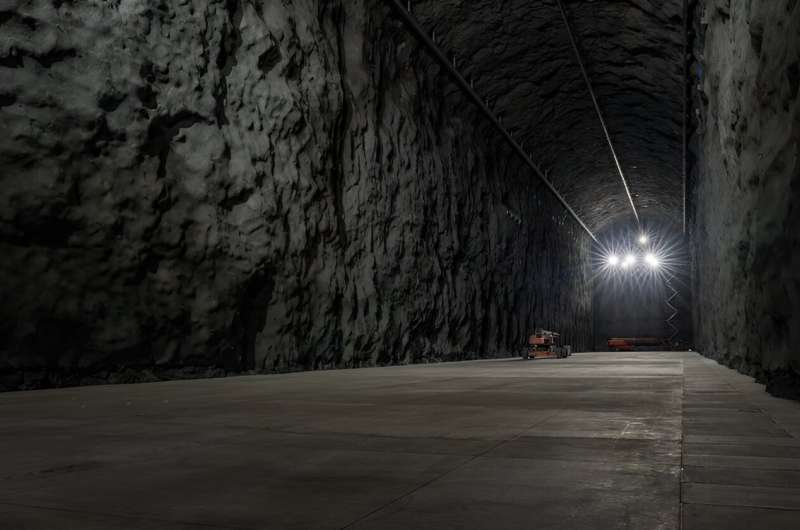
OCTOBER 7, 2024 by Shannon Brescher Shea, US Department of Energy
Collected at: https://phys.org/news/2024-10-neutrino-lbnf-dune-excavation-tons.html
As a kid, you may have tried to dig a hole in your backyard to reach China. Obviously, that didn’t happen. But digging out a lot of ground can be quite productive. Instead of reaching another country, the scientists, engineers, and construction workers on the LBNF-DUNE project dug up rock to enable groundbreaking science.
More specifically, they excavated 800,000 tons of rock from the Sanford Underground Research Facility in Lead, South Dakota. This excavation is a major step forward in a multi-year process to build the biggest, most advanced, and most comprehensive project to study neutrinos yet.
The caverns they excavated will hold a massive particle detector and accompanying equipment. Along with partners from more than 35 countries, the Department of Energy’s Office of Science is supporting the Deep Underground Neutrino Experiment at the Long-Baseline Neutrino Facility (LBNF-DUNE) to help answer some of physics’ biggest questions.
Mysterious particles
Neutrinos are subatomic particles that are so small that their name means “little neutral one” in Italian. Almost 100 years ago, physicists theorized that neutrinos existed when certain interactions between particles seemed to be “missing” energy. In 1956, scientists detected neutrinos for the first time. Since then, neutrinos have continued to surprise scientists.
One of the biggest surprises was the fact that neutrinos have mass. For most objects, having mass is a given. But, as per the Standard Model of Particle Physics—our current best model to describe the universe—neutrinos should not have mass. Physicists are still trying to figure out what their mass is and how they even have mass at all.
The other major surprise was that there are three different types of neutrinos and the particles switch between types as they travel. In fact, this transformation is one of the major reasons why physicists are so interested in them. Scientists think this characteristic may hold the key to answering a huge question in physics—why is there something rather than nothing?
Unexplained physics
As the behavior of neutrinos shows, the Standard Model of Particle Physics doesn’t quite explain some important aspects of our universe. One of them is the fact that there is more matter than antimatter. According to our current understanding, just after the Big Bang there should have been equal amounts of matter and antimatter. (Antimatter particles are identical to their ordinary matter partners except that they have an opposite charge.)
But when matter and antimatter meet, they annihilate each other. So somewhere in the unimaginably short moments of the beginnings of the universe, there must have been a tiny bit more ordinary matter. That miniscule amount that was left after the matter-antimatter interaction led to everything else in the universe.
Scientists have many theories to explain this imbalance. One possibility is that it has to do with neutrinos and their antimatter partners.
To study how neutrinos change type as they travel, LBNF-DUNE will be sending a stream of neutrinos from DOE’s Fermilab National Accelerator Laboratory in Illinois to South Dakota. At the beginning and end of the particles’ journey, detectors will measure the types of neutrinos and antineutrinos. By comparing the rates of how both particles change type, scientists may find a difference that accounts for that ancient misalignment.
LBNF-DUNE will also provide insight into other major questions in physics. As some stars come to their end of their lives, they explode. When that happens, neutrinos are the first particles they release. Further along in the process, these exploding stars (called supernovae) form elements including those essential to life like carbon, oxygen, and iron. By detecting neutrinos from these events, LBNF-DUNE could allow scientists to catch supernovae in the act.
DUNE’s detectors are also designed to detect other particles. As far as we know, protons are the only composite particles—a particle made of other types of particles—that don’t break down in nature. It’s not clear if protons don’t break down at all or if it’s so rare that scientists have never spotted it.
If protons do break down, that process could offer a clue to whether there was ever one single fundamental force or if the four we have today existed since the Big Bang. It could also indicate whether the universe will go on forever or have an ending point. If this process exists, LBNF/DUNE is designed to potentially detect it.
Capturing a ghost
Some of the things that make neutrinos intriguing also make them difficult to study. One of the most striking aspects of neutrinos is that they have almost no interactions with other particles. As a result, they can travel huge distances through space without being affected by cosmic objects. It also means that they are very difficult to detect.
To solve this problem, LBNF-DUNE will use massive, seven-story tall detectors. Each detector will have 17,000 tons of liquid argon. That vast quantity of liquid maximizes the likelihood that scientists will detect as many neutrinos as possible. The far detector—the one in South Dakota—will be located about a mile underground. That distance places it in the right location compared to Fermilab and blocks the detector from other cosmic particles.
Just carrying out the excavation took three years. The team had to dissemble the equipment, move it deep underground, and then reassemble it. As they dug out the caverns, the team moved 800,000 tons of rock up to the surface and deposited it in an area that had formerly been a mine.
Now that the excavation is complete, the LBNF-DUNE team is moving on to the next steps. Currently, they are installing the far detector in the Sanford Underground Research Facility. They anticipate finishing construction and starting to operate the detector in 2028. The team will then move on to installing the near detector at Fermilab.
The launch of LBNF/DUNE will be the beginning of a new era in understanding neutrinos and knowing more about our universe as a whole.

Leave a Reply